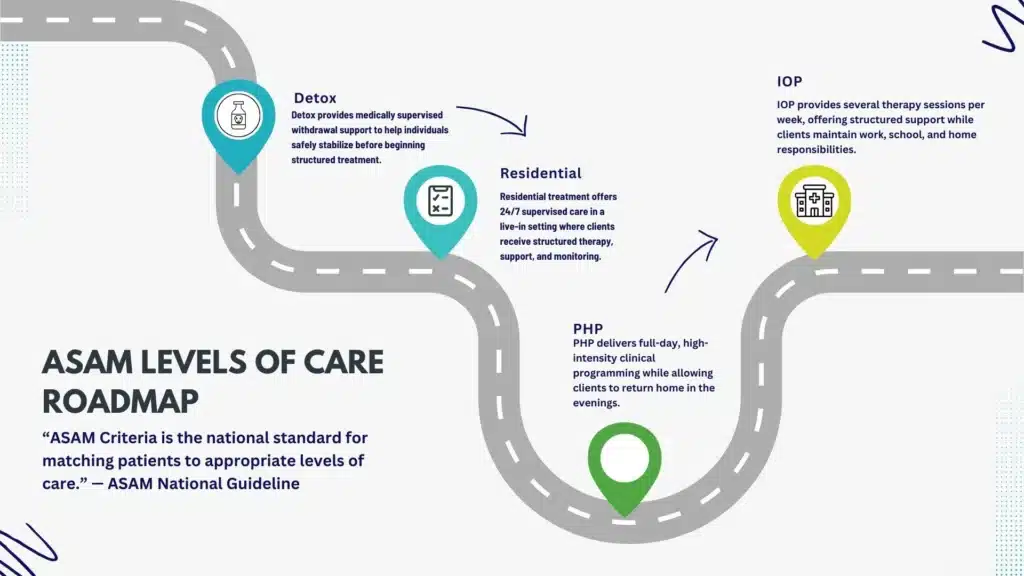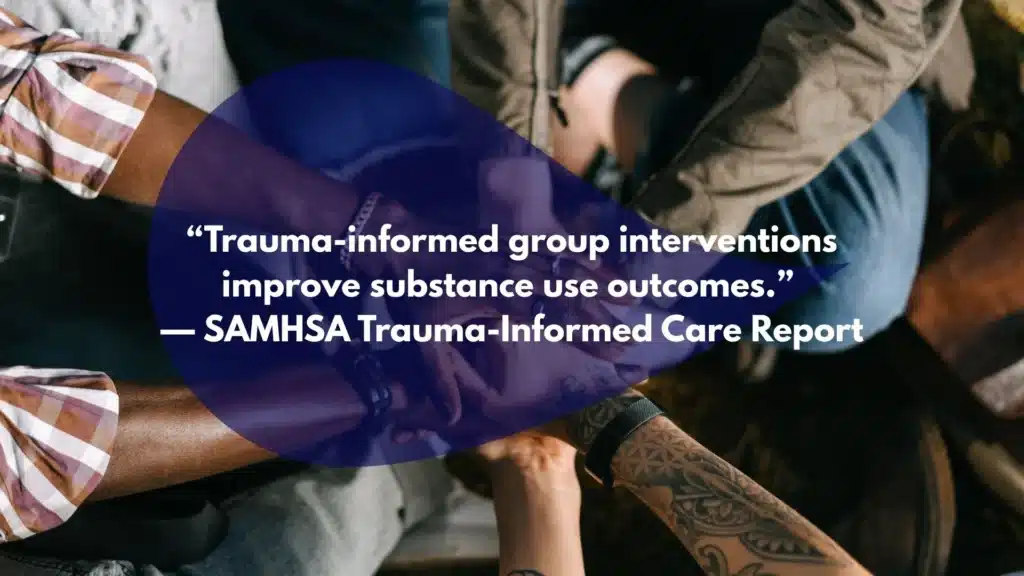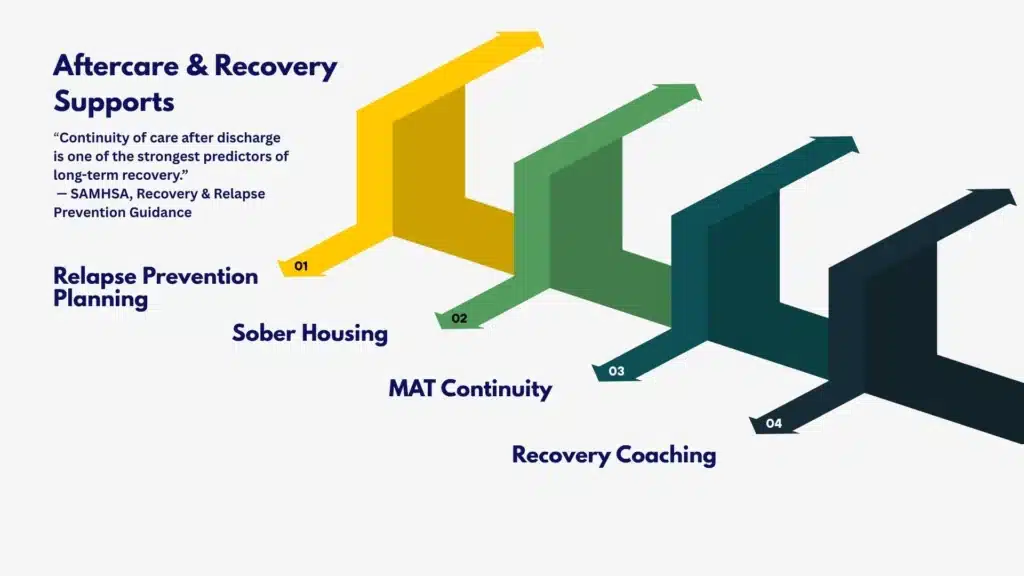Choosing drug and alcohol treatment in New Jersey should be clear, safe, and grounded in evidence. At Rolling Hills Recovery Center, licensed clinicians deliver structured outpatient services with co-occurring expertise. This overview explains admissions, therapies, insurance, and privacy basics, and aftercare, so families can make informed, confident decisions.
Key Takeaways
- Prioritize safety and quality: Joint Commission accreditation, New Jersey DMHAS licensing, physician-led care, and capacity to treat co-occurring mental health needs.
- Match care to need using ASAM levels, detox, residential, PHP, IOP, outpatient, so treatment intensity fits symptoms & risks, not the other way around.
- Verify insurance early: check in-network status, deductible, and copays, any prior authorization; record the rep’s name and reference number, which supports appeals if needed.
- Admissions and aftercare matter: rapid pre-screen, same-day intake when appropriate, thorough biopsychosocial assessment, then a clear relapse-prevention plan with MAT continuity, family work & sober supports.
What a New Jersey Drug Rehab Treatment Center Provides
A comprehensive drug rehab treatment center in New Jersey is designed to stabilize withdrawal, treat substance use disorder (SUD), manage co-occurring mental health conditions, and help patients build a durable recovery plan.

Rolling Hills Recovery Center aligns care with current evidence and New Jersey regulations, offering both clinical and holistic approaches delivered by licensed professionals.
Patients and families usually decide based on a short list of high‑impact factors: independent accreditation, access to medications for addiction treatment (MAT), evidence-based addiction treatment, New Jersey licensing, and insurance acceptance.
Levels of Care at a Glance
New Jersey programs use the American Society of Addiction Medicine (ASAM) Criteria to match patients to the safest, least restrictive setting that meets clinical need. Centers generally offer a continuum so patients can step up or down as they progress.

| Level of Care | Primary Aim | Typical Length | Key Features | Who It Fits Best |
|---|---|---|---|---|
| Medical Detox (Withdrawal Management) | Safe, medical management of acute withdrawal | 3–10 days, varies by substance | 24/7 nursing; physician oversight; symptom-targeted meds; safety monitoring | Patients at risk of severe withdrawal (alcohol, benzodiazepines, opioids) |
| Residential / Inpatient | Stabilization, skill building, structure | 2–6 weeks or longer | 24-hour support; daily therapy; medication management; recovery routines | Patients needing a controlled, therapeutic environment |
| Partial Hospitalization Program (PHP) | Intensive day treatment without overnight stay | 2–4 weeks on average | 5–6 days/week; medical & psychiatric oversight; group and individual therapy | Patients stepping down from inpatient or needing high structure |
| Intensive Outpatient Program (IOP) | Ongoing therapy with work/school balance | 6–12 weeks commonly | 3–5 days/week; evidence-based groups; relapse prevention; MAT support | Patients with stable housing and moderate support needs |
| Standard Outpatient | Maintenance therapy and check-ins | Variable; months or more | Weekly or biweekly sessions; medication follow-up; recovery goals | Patients with strong recovery supports or in long-term follow-up |
Most centers maintain licensed clinicians, integrated dual-diagnosis capability, and a multidisciplinary team (physicians, nurse practitioners, licensed counselors). Safety protocols include medical oversight during withdrawal, active monitoring for suicide risk, drug–drug interaction checks, and transport coordination to a higher level of care when needed.
Accreditation by The Joint Commission for behavioral health is a strong quality marker. Patients should verify current accreditation status and New Jersey licensing, and ask if the program uses validated, evidence-based treatments such as cognitive behavioral therapy (CBT), dialectical behavior therapy (DBT), contingency management, and FDA-approved medications for opioid and alcohol use disorders.
Availability of MAT (buprenorphine, methadone, naltrexone) on site or via coordinated referral is essential for opioid and alcohol use disorders.
Rolling Hills Recovery Center offers evidence-based and holistic services delivered by experienced professionals to help patients achieve lasting results. Those exploring a rehabilitation center for drug addiction in New Jersey can review options here: rehabilitation center for drug addicts.
Admissions and Assessment: How Entry Works
Admissions should be fast, respectful, and clinically sound. The goal is to reduce barriers, start stabilization, and tailor care from day one.
Pre‑Admission Screening
Step 1: Brief clinical screen by phone. An admissions specialist gathers substances used, amount, and last use, medical and psychiatric history, medications, prior treatment, legal or family concerns, and immediate risks (overdose, withdrawal, self-harm). This guides provisional placement and determines whether medical detox is needed first.
Step 2: Insurance and benefits check. With consent, staff verify insurance eligibility, in-network status, copays, deductibles, and prior-authorization needs. If uninsured, financial options are reviewed. For New Jersey residents, NJ FamilyCare/Medicaid eligibility and charity care pathways may be assessed.
Step 3: Schedule the intake. Many centers offer same-day or next-day admission for detox and urgent cases. For planned admissions, labs can be pre-ordered, and transportation or family drop-off can be coordinated.
Arrival and Intake
Step 4: Immediate safety check. On arrival: vitals, review of withdrawal risk, medication reconciliation, pregnancy status when indicated, and screening for intoxication. If the risk is high, medical orders are initiated right away.
Step 5: Comprehensive biopsychosocial evaluation. A licensed clinician completes a structured assessment covering medical, psychiatric, family, social, legal, housing, employment, trauma, and recovery history. Standard tools (e.g., PHQ-9 for depression, GAD-7 for anxiety, Columbia-Suicide Severity Rating Scale) may be used to quantify symptoms.
Step 6: Drug testing and lab work. Objective testing confirms recent substance use and helps tailor the withdrawal and medication plan. Baseline labs are ordered as indicated (CBC, CMP, hepatic panel, pregnancy test, ECG for methadone when needed).
Step 7: ASAM Level Placement. Using ASAM’s six dimensions, the team determines the appropriate level of care. Placement is revisited frequently as the patient stabilizes or if risks emerge.
Step 8: Immediate risk management. For acute symptoms (e.g., severe alcohol withdrawal, benzodiazepine dependence, suicidality), physicians start protocols immediately and consider higher-monitoring settings when warranted. Naloxone education may begin day one.
How Families Coordinate Care and Transportation
- Families can participate with patient consent. Staff explain 42 CFR Part 2 privacy rules and how consent forms allow updates to designated family members.
- Transportation support is arranged when needed. If medical transport is required, admissions coordinates with licensed services.
- Family orientation covers visitation rules, communication schedules, and how to support recovery without enabling. Family sessions are scheduled early in treatment to align goals.
Treatment Modalities and Medical Care
Modern SUD treatment integrates medications, psychotherapies, and recovery supports and employs a multidisciplinary plan that adjusts based on outcomes data and patient preference.
Medications for Opioid and Alcohol Use Disorder
- Buprenorphine (SL/extended-release): Reduces cravings and withdrawal for opioid use disorder (OUD); usually started after mild–moderate withdrawal begins or via micro-induction when fentanyl exposure is likely.
- Methadone: Full agonist MAT option for OUD delivered via certified opioid treatment programs; ECG monitoring considered for QT risk.
- Naltrexone (oral or extended-release): For alcohol use disorder (AUD) and OUD after detox; requires opioid-free period before initiation.
- Adjuncts for AUD: Acamprosate or disulfiram when clinically appropriate.
- Withdrawal management: Symptom checklists (e.g., CIWA-Ar for alcohol, COWS for opioids) guide benzodiazepine tapers, alpha-2 agonists, antiemetics, sleep, and pain management.

Medication decisions weigh risks, benefits, co-occurring disorders, and patient goals. Education addresses myths, safe storage, and how MAT supports, not replaces, therapy and skill building. For those seeking support for prescription medications, see prescription drug addiction treatment.
Evidence-Based Psychotherapies and Skills

- CBT: Identifies triggers, thoughts, and behaviors; builds coping and refusal skills.
- DBT-informed work: Distress tolerance, emotion regulation, mindfulness, and interpersonal effectiveness to reduce impulsivity and self-harm risk.
- Contingency Management: Small, meaningful reinforcers for meeting targets (negative drug screens, attendance).
- Trauma-Informed Therapy: Safety, trust, choice, collaboration, empowerment. Individual trauma therapy is paced carefully to avoid destabilization during early recovery.
- Family Sessions: Education on SUD as a chronic, treatable condition; communication skills; boundary setting; relapse response planning.
- Culturally Competent Care: Respect for language, identity, faith, and cultural healing practices; interpreters and tailored materials as needed.
Daily Structure and Recovery Routines
In residential and PHP, patients follow a predictable day: morning vitals and meds, group therapy, psychoeducation, skills practice, individual therapy, family or case management sessions, wellness activities (yoga, light fitness), and reflection.
Evenings emphasize peer support, journaling, and preparation for sleep hygiene. In intensive outpatient programs (IOP)/outpatient, therapy is scheduled around work or school; medication follow-ups and random urine drug screens maintain accountability.
A modest amenities focus, quiet spaces, privacy, nutritious meals, and optional holistic activities support engagement. Patients who prefer upgraded comfort can explore a luxury rehab center in NJ; what matters most clinically remains accreditation, MAT access, and evidence-based care.
Care Planning and Recovery Capital
Each patient receives an evolving care plan with measurable goals tied to six domains: substance use, mental health, medical stability, family/social relations, housing/employment/education, and legal needs. Case management builds “recovery capital,” such as:
- Safe housing (including sober living referrals)
- Employment readiness or protected leave support
- Linkage to primary care, psychiatry, and pain specialists
- Transportation solutions (bus passes, ride shares)
- Mutual-help or peer recovery coaching
Outcomes Tracking and Quality
Progress is tracked with regular urine drug screens, self-reported cravings, mood scales, sleep quality, and appointment adherence. Clinicians review outcomes weekly. If risk rises, missed groups, escalating cravings, positive screens, the team adds supports (e.g., higher level of care, contingency management, medication adjustment, extra family session). Programs also monitor readmissions, completion rates, and patient experience to improve care.
Insurance, Costs, and New Jersey Compliance
New Jersey residents have legal protections and options that can reduce cost barriers. Early benefits verification prevents surprise bills and speeds admission.
Verifying Benefits and Understanding “In-Network”
Step 1: Provide your insurance card and date of birth to admissions. Staff verify eligibility, plan type, and whether the center is in-network. “In-network” means the provider has a contract with your plan to accept negotiated rates, typically lowering out-of-pocket costs.
Step 2: Ask for estimated costs. Request a good-faith estimate outlining deductibles, copays, and coinsurance for each level of care. For out-of-network care, ask if the center can obtain a single-case agreement.
Step 3: Clarify prior authorization. Many plans require pre-approval for residential/PHP/IOP. The admissions team can submit clinical notes and ASAM justifications to your insurer; providing accurate contact information and availability helps avoid delays.
New Jersey FamilyCare (NJ Medicaid) covers many SUD services. Commercial plans fall under mental health parity laws, which require comparable coverage for behavioral health and medical/surgical benefits. If a claim is denied, ask for the reason in writing, appeal deadlines, and what clinical documentation is missing. Keep all explanations of benefits (EOBs).
Privacy, Safety, and Oversight
- 42 CFR Part 2: Strict federal confidentiality rules protect SUD treatment records. Written patient consent is required before sharing information with family or other providers, except in emergencies or as permitted by law.
- DMHAS Oversight: The New Jersey Division of Mental Health and Addiction Services (DMHAS) licenses and monitors programs. Patients may confirm a facility’s license status and file complaints with the state when needed.
- Accreditation: The Joint Commission behavioral health accreditation confirms adherence to rigorous quality and safety standards, including medication management, infection control, emergency preparedness, and data-driven improvement.
What to Ask Billing Before Admission
- Are you in-network with my plan? If not, can you seek a single-case agreement?
- What will I owe at admission and at discharge?
- What happens if my insurer denies or shortens authorization mid-treatment?
- How do you handle refunds, overpayments, or financial hardship?
If finances are tight, request a payment plan, sliding scale (if available), or community resources. Ask whether medications (including extended-release naltrexone) are billed under medical vs. pharmacy benefits—this affects copays.
Aftercare and Long-Term Recovery Supports
Since SUD is a chronic condition with relapse risk, aftercare planning starts early. The aim is to make transitions smooth, keep protective factors high, and respond quickly if symptoms recur.

Relapse Prevention Planning
A written plan should identify top triggers, early warning signs, specific coping strategies, and people to call. Patients can carry a one-page summary listing:
- Personal triggers and two “first steps” to interrupt them
- Backup coping skills if the first steps fail
- Names and numbers for sponsor/peer, therapist, family, and a crisis line
- Medication schedule and what to do if a dose is missed
This plan is rehearsed before discharge and shared, with consent, with key supports.
MAT Continuity and Medical Follow-Up
- Continue MAT without gaps. Set the first post-discharge appointment before leaving, confirm the pharmacy, and verify prior authorization for extended-release formulations.
- Primary care linkage. Screen and update vaccinations, address sleep, nutrition, chronic disease, tobacco cessation, and reproductive health.
- Psychiatric care. Maintain or adjust antidepressants, mood stabilizers, or anxiolytics in a coordinated plan to avoid benzodiazepine dependence.
If a patient is not ready for abstinence, harm reduction steps, naloxone training, fentanyl test strips, never using alone, and infection prevention, reduce overdose and infectious disease risk. Education is practical, judgment-free & repeated.
Sober Housing and Community Supports
Case managers coordinate sober living when home environments are high risk. Alumni staff introduce local mutual-help meetings and recovery community centers. Clinics can connect patients to transportation vouchers, employment programs, and educational supports. Family coaching may continue to reinforce healthy boundaries.
A strong alumni program offers check-in calls or texts, monthly groups, volunteer opportunities, and quick re-entry pathways if help is needed. Many centers maintain a 24/7 line for crisis triage and rapid placement.
Monitoring Metrics After Discharge and How to Adjust
Practical indicators help patients and clinicians track stability:
- Random urine screens and breathalyzers
- Appointment attendance and punctuality
- Medication adherence (pharmacy fills, pill counts when needed)
- Self-rated craving scores and sleep quality
- Work or school attendance and family feedback (with consent)
If any metric flags concern, missed appointments, rising cravings, or positive screens, the plan is adjusted the same week. Typical changes include adding extra therapy sessions, restarting or optimizing MAT, brief return to PHP/IOP, or short residential stabilization. Families are given a simple “if–then” script: if the patient misses two visits or reports strong urges, call the clinician within 24 hours; if safety is at risk, call 988 or 911.
Practical Tools and Templates Patients Find Useful
- Admissions call script: “I’m seeking help for [substance]. Last use was [date/time]. I have [insurance plan]. I may need detox. Do you have same-day availability, and can you verify my benefits now?” Keep your ID and medication list handy.
- Medication wallet card: List each medication, dose, prescriber, pharmacy, and allergies. Add “carries naloxone” if applicable.
- Appointment grid: A one-page weekly calendar with checkboxes for therapy, groups, MAT dosing, pharmacy pickups, and mutual-help meetings. Post on the fridge; share a photo with your case manager weekly.
- Relapse prevention one-pager: Front side = triggers and skills; back side = emergency contacts and crisis numbers.
These simple tools improve coordination and reduce slips during transitions.
Quality Signals Patients Should Prioritize
- Independent accreditation (The Joint Commission) and current New Jersey license, easy to verify upon request
- Evidence-based care documented in the program schedule and your treatment plan (CBT, DBT, contingency management)
- Clear access to MAT (buprenorphine, methadone via OTP referral when needed, naltrexone), with same-week starts
- Integrated care for co-occurring mental health disorders
- Transparent billing with written estimates and help with prior authorizations
- Outcomes monitoring with timely care-plan changes when risks rise
Where to Learn More
- NIDA’s Principles of Drug Addiction Treatment: research-based fundamentals, levels of care, and effective modalities.
- SAMHSA TIP 63: Medications for Opioid Use Disorder—induction, dosing, monitoring, and retention strategies.
- NJ Department of Human Services, Division of Mental Health and Addiction Services (DMHAS): licensing, treatment locators, and consumer rights.
- The Joint Commission Behavioral Health Care and Human Services Accreditation: program standards and what accreditation means.
Conclusion
Choosing drug rehab in New Jersey comes down to safety, evidence-based care, and fit. Key takeaways: accreditation & licensed clinicians, co-occurring care and MAT, clear admissions and insurance. When ready, verify benefits, arrange intake, then start care.
Frequently Asked Questions (FAQs)
What Makes a Drug Rehab Treatment Center in NJ Effective?
An effective drug rehab treatment center in NJ is licensed by the state, uses evidence-based care (such as CBT, motivational interviewing, and medication-assisted treatment), and treats co-occurring mental health & substance use disorders together. Care should match ASAM levels, from medical detox to residential, PHP, IOP, and outpatient.
Look for individualized treatment plans, trauma-informed practices, qualified clinicians (physicians, nurses, licensed therapists), and structured family involvement. Safety protocols, medication management, regular outcome tracking, and clear aftercare planning matter just as much. When these are in place, patients see better, steadier outcomes.
How Can Someone Check Insurance Coverage for a Drug Rehab Treatment Center in NJ?
Call the number on the back of the insurance card and ask about behavioral health benefits for a drug rehab treatment center in NJ. Confirm in-network status, required preauthorization, deductibles, and any day limits. Ask specifically about detox & residential, PHP, IOP, and outpatient therapy.
The center’s admissions team can also run a confidential benefits verification with consent. Have the member ID, date of birth, and home ZIP ready. In New Jersey, commercial plans and NJ FamilyCare may cover levels of care when medically necessary; parity laws apply, but plans still need clinical review. Keep notes, date, name of representative, and reference number, simple, but helpful for appeals if needed.
What Happens During Admission and Detox at a Drug Rehab Treatment Center in NJ?
Admission starts with a medical and psychosocial assessment that reviews substances used, withdrawal risks, mental health, and medical history. Basic labs may be ordered. A physician prescribes a detox plan to manage withdrawal safely with monitoring, using tools like CIWA for alcohol and COWS for opioids when indicated.
Detox is short-term stabilization, not full treatment. Typical timelines vary: alcohol 3–7 days, opioids 4–10 days, benzodiazepines may require slower tapers. Patients then transition to the next level of care in NJ, residential, PHP, or IOP, so treatment does not stop at detox. Sleep, nutrition, and hydration are supported; safety first, comfort second, speed third.
What Does Aftercare Look Like After Completing a Drug Rehab Treatment Center in NJ?
Aftercare starts before discharge. A solid plan may include ongoing therapy, IOP or outpatient sessions, medication management (for MAT or psychiatric needs), and relapse prevention coaching. Many patients benefit from recovery-supportive housing and scheduled community support meetings, and simple routines help.
Expect a written safety plan, coping skills rehearsal, and coordinated family sessions when appropriate. Telehealth options can help with work & childcare. Follow-up visits are front-loaded in the first 30–90 days, when relapse risk is higher, then spaced out as stability improves.
Why Consider Rolling Hills Recovery Center When Searching for a Drug Rehab Treatment Center in NJ?
Rolling Hills Recovery Center emphasizes thorough assessment, integrated mental health care, physician-led medication management, and measurable outcomes. Treatment plans are individualized, with trauma-informed therapy, family involvement, and structured aftercare. The team is New Jersey-based, understands local resources & regulations, and prioritizes continuity of care across detox placement, PHP, IOP, and outpatient, so patients are not left to navigate recovery alone.
Author
-
Our editorial team includes licensed clinicians and board-certified addiction specialists. Every article is written and reviewed to be clear, accurate, and rooted in real treatment experience.
View all posts -
Dr. Williams has held senior leadership positions in the behavioral health field for over 30 years. He has worked with diverse populations in various private and public sectors.
View all posts












